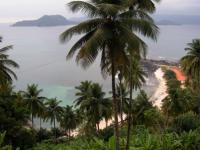 Meanwhile, at the resort, the tourist gets bored with the life of being comfortably laying down, among flabby women taking selfies, strutting families, monotonous food, and swimming pools all the time. The entertainment area only offers the disinterest of bored couples, or a group of bank colleagues getting loudly drunk. The islet has little of the Africa he had dreamed of (except for the impressive landscape, but that resembled some corner of Brazil). The local inhabitants, all expelled for pocket change to build little houses and free up the islet for tourists. A few young people from São Tomé who come and go in little rubber boats to sell handicrafts to tourists and fish to the restaurants. If he manages to extract information about the lives of the “locals,” as he was told, it is perfectly conditioned by the commercial relationship that mediated them.
Meanwhile, at the resort, the tourist gets bored with the life of being comfortably laying down, among flabby women taking selfies, strutting families, monotonous food, and swimming pools all the time. The entertainment area only offers the disinterest of bored couples, or a group of bank colleagues getting loudly drunk. The islet has little of the Africa he had dreamed of (except for the impressive landscape, but that resembled some corner of Brazil). The local inhabitants, all expelled for pocket change to build little houses and free up the islet for tourists. A few young people from São Tomé who come and go in little rubber boats to sell handicrafts to tourists and fish to the restaurants. If he manages to extract information about the lives of the “locals,” as he was told, it is perfectly conditioned by the commercial relationship that mediated them.
Mukanda
27.05.2024 | by Marta Lança